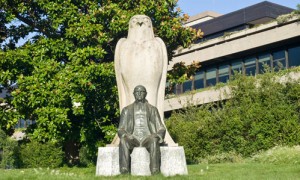One Museum, two Collections
As from this June, at the time of commemorations of the 60th anniversary of the Gulbenkian Foundation, the Calouste Gulbenkian Museum and the José de Azeredo Perdigão CAM – Centre of Modern Art are to combine their respective identities under a shared entity – the Calouste Gulbenkian Museum – and henceforth identified by their respective collections:
Calouste Gulbenkian Museum / The Founder’s Collection
Calouste Gulbenkian Museum / The Modern Collection
The objective involves fostering a dialogue between the two collections: that of the Calouste Gulbenkian Museum, which reflects the tastes of a renowned collector, and the CAM, built up in the wake of his death and that results from the Foundation acting in the name of the founder’s legacy. Together, they throw up a broad panoramic view over artistic production from the classical era through to the contemporary period.
The Calouste Gulbenkian Foundation has always identified the need to interrelate, in the most effective fashion, its two museological collections in order to best nurture synergies and leverage the strengths of each collection, affirming their differences in terms of the programming whilst also communicating externally in efforts to merge the publics visiting them.
The joint “Meeting Point” program has in the last two years proven the opportunity to contrast works from the Founder’s Collection with those from the Modern Collection and representing the first step in this same direction.
The decision to establish a single management structure for the two museums, headed by the British art curator and historian Penelope Curtis, who took up functions at the Foundation last September, represented another advance in this merger that shall be implemented through a new organisational model that integrates transversal teams across the two museums.
This thus strives to aggregate the two museological centres into a single museum, named after the Founder and valuing each of the two collections through means of the interwoven attraction of audiences within the framework of ensuring the largest number of visits. For the CAM itself, this conveys a greater affirmation of its scale as a museum and endowing a more complete sense of value to the Modern and Contemporary Art Collections built up since the Foundation’s establishment.
The two collections will continue to be perceived as distinctive in their own rights – one closed and the other open and in continuous growth – but seeks in this way to stimulate the bridges and interconnections between them. To this end, the new director draws upon a single, common team to manage the two collections and not teams exclusively allocated to each museum as had thus far been the case.
According to Penelope Curtis, who ran Tate Britain between April 2010 and June 2015, a shared identity will enable comparisons between the two institutions and render the Modern Collection more visible in keeping with the objective of boosting its international profile. This measure thus seeks to encourage the museum’s public to visit the modern collection, raising the general level of awareness and especially attracting more international visitors.
An early example of this dialogue, there comes in May the unprecedented presentation of a set of 19th and 20th century carpets from Kumkapi (an Istanbul neighbourhood) from the Gulbenkian Museum and placed on display alongside a carpet recently created by Mehkitar Garabedian (b.1977, Aleppo), one of the artists who featured in the greatly praised Armenia Pavilion at the latest Venice Biennial. The historical similarities between displaced Armenians proves highly surprising and in the case of the Armenian weaver Hagop Kapoudjian (c.1869-1946), responsible for three of the four Kumkapi carpets on exhibition, also proving intimately bound up with the story of Calouste Gulbenkian himself.
A second defining moment takes place in June on the occasion of the commemorative exhibition marking the 60th anniversary of the Gulbenkian Foundation, which, in the words of Penelope Curtis, “will cross-reference the two collections and show just how startlingly well both reflect the 20th century.” Adopting the year of 1956 as the central point, the presentation moves forwards and backwards through time, interweaving works from the two collections that simultaneously represent different versions of the concept of modernity.
The Foundation’s Education Service has already approached the two collections as a single heritage legacy in a trend that the shared management structure shall now only serve to deepen.
The near future will see programming make recourse to both collections, including both historical and contemporary exhibitions alongside an ever increasing level of mutual dialogue.

